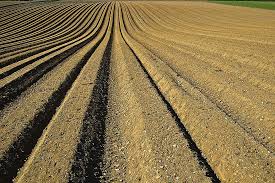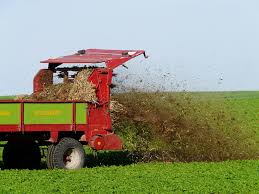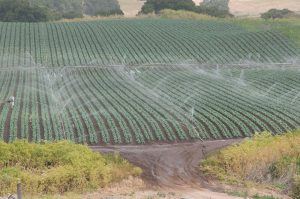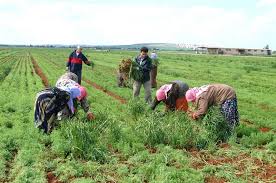

Preparation of soil:
Before raising a crop, the soil in which it is to be grown is
prepared by ploughing, levelling, and manuring. Ploughing is the
process of loosening and digging of soil using a plough. This
helps in proper aeration of the soil. After ploughing, the soil
is distributed evenly and levelled in the process called
levelling. The soil is then manured.The soil is the basis of
agricultural production. When certain environmental conditions
are present, the creation of soil is the result of a confluence
of processes that can be classified as either physical,
chemical, or biological. Both living and nonliving components
combine to form the soil in its entirety. Agricultural soil
science is a subfield that focuses on investigating soil and
edaphic conditions with the cultivation of food and fibre crops.
The complex combination of minerals, organic matter, water, air,
and other elements that make up soil is what makes it possible
for life to exist on earth.
Equipment used for preparing soil Ploughs, hoes, and cultivators
or discs are the three primary types of implements that are
utilised in the process of soil preparation. The plough The
plough was a straightforward piece of farm equipment that
farmers utilised in days gone by. It has a pointy corner and is
in the shape of a triangle. Ploughing is typically done by
animals like oxen, bulls, and other similar creatures. Beam,
ploughshare, and plough shaft are the three primary components
of this tool. Hoe A hoe is a straightforward instrument used to
clear away weeds and break up the soil. It consists of a long
handle made of wood that is coupled to a variety of blades made
of iron. When used in agricultural areas, it is also sometimes
dragged by animals. Cultivator An agricultural cultivator is a
sophisticated tool that farmers utilise. It helps save a
significant amount of time, effort, and energy. When used for
ploughing, it is attached to a tractor.
The first and most
crucial stage in soil preparation is tilling or ploughing the
soil. The act of turning over and breaking up the soil is
referred to as ploughing. Another name for this activity is
tilling. When ploughing, a bull is used, and it is linked to a
beam, which is then connected to either a wooden or an iron
plough. Tractors can also be used to till the soil during
ploughing. The value of working the land: (a) It helps loosen
the soil, which allows the roots to penetrate deeper into the
ground, and it assists the roots in taking in oxygen.
Earthworms, sometimes known as “farmer’s buddies,” and the
bacteria that live in the soil both benefit from having the soil
loosened up.

Sowing:
Sowing, also known as seeding, is the art of placing a
seed in suitable soil conditions for proper germination
and growth. Seeding entails planting the right number of
seeds per unit area, the depth at which the seeds are
buried in the soil, and the distance between rows.Here are
a few safeguards, which should be taken during this
agricultural procedure, including selecting high-quality
seeds, maintaining the proper depth and distance, and
ensuring the soil is clean, healthy, and free of pathogens
like fungus and other diseases. For seeds to germinate—the
process by which seeds grow into new plants—all these
measures are necessary.Once the soil is arranged, the crop
is planted. This is done in many ways. Rice is sown using
the method of transplanting seedlings. Vegetables like
ladyfinger are sown on the ridges while green leafy
vegetables like spinach are sown in beds. Vegetables like
bitter gourd, pumpkin and watermelon are sown by poking
them inside the soil one by one.Extensive root penetration
can be achieved by stirring and loosening the soil. The
growth of numerous soil bacteria, earthworms, etc., which
enrich the soil with humus and other necessary nutrients,
is facilitated by loosening the soil. The seeds were
usually sown using an instrument shaped like a funnel. The
funnel is full of seeds, which go through two or three
pipes with pointy, sharp ends. On the plough shaft, the
tool is attached. When seeds are kept in a funnel, they
gradually descend through the pointed ends that pierce the
ground, planting themselves deeply. Traditionally dropping
seeds by hand is known as ‘ Kera’ and dropping seeds
through a mechanical method is called ‘Pora’.
Dribbling is the most typical method of inserting seeds
into holes drilled in the seedbed and covering them. In
this technique, holes are drilled at a specific depth and
spaced at a particular distance apart to place seeds. The
dibbler is the equipment used for dibbling. To make
precise boreholes in the field, a conical tool is
employed. In this approach, seeds are inserted into
apertures constructed at a specified dispersal depth and
clear profundity. Tiny seedlings shouldn’t go through this
cycle because it is so laborious. Dribbling is the most
famous technique are used to plant crops.

Manuring:
Manures are plant and animal wastes that are used as
sources of plant nutrients. They release nutrients after
their decomposition. The art of collecting and using
wastes from animal, human and vegetable sources for
improving crop productivity is as old as agriculture.
Manures are the organic materials derived from animal,
human and plant residues which contain plant nutrients in
complex organic forms. Naturally occurring or synthetic
chemicals containing plant nutrients are called
fertilizers. Manures with low nutrient, content per unit
quantity have longer residual effect besides improving
soil physical properties compared to fertilizer with high
nutrient content.
Major sources of manures are: Cattle shed wastes-dung,
urine and slurry from biogas plants Human habitation
wastes-night soil, human urine, town refuse, sewage,
sludge and sullage Poultry Jitter, droppings of sheep and
goat Slaughterhouse wastes-bone meal, meat meal, blood
meal, horn and hoof meal, Fish wastes Byproducts of agro
industries-oil cakes, bagasse and press mud, fruit and
vegetable processing wastes etc Crop wastes-sugarcane
trash, stubbles and other related material Water hyacinth,
weeds and tank silt, and Green manure crops and green leaf
manuring material. Farmyard manure refers to the
decomposed mixture of dung and urine of farm animals along
with litter and left over material from roughages or
fodder fed to the cattle. On an average well decomposed
farmyard manure contains 0.5 per cent N, 0.2 per cent
P2O5and .0.5 per cent K2O.The present method of preparing
farmyard manure by the farmers is defective. Urine, which
is wasted, contains one per cent nitrogen and 1.35 per
cent potassium. Nitrogen present in urine is mostly in the
form of urea which is subjected to volatilization losses.
Even during storage, nutrients are lost due to leaching
and volatilization. However, it is practically impossible
to avoid losses altogether, but can be reduced by
following improved method of preparation of farmyard
manure. Trenches of size 6 m to 7.5 m length, 1.5 m to 2.0
m width and 1.0 m deep are dug. All available litter and
refuse is mixed with soil and spread in the shed so as to
absorb urine. The next morning, urine soaked refuse along
with dung is collected and placed in the trench. A section
of the trench from one end should be taken up for filling
with daily collection. When the section is filled up to a
height of 45 cm to 60 cm above the ground level, the top
of the heap is made into a dome and plastered with cow
dung earth slurry. The process is continued and when the
first trench is completely filled, second trench is
prepared.

Irrigation:
rrigation systems are unnaturally applying water to
plants, rainfall is not properly adequate to maintain
crops. It is most commonly utilized in locales where
rainfall is inadequate. Plants need water to survive and
grow, it helps bring supplements into their frameworks,
permitting them to photosynthesize. The water system’s
ancient uses date back to around 6000 B.C.E. in Egypt and
Mesopotamia, rainfall and flooding were normal.
Conventional techniques for agricultural irrigation
included digging canals, utilizing a pulley framework and
utilizing water wheels to supply water from streams to the
crops. These practices were modest and straightforward to
keep up with, irrigation farming for water systems is not
possible to utilize any longer. They are tedious, work
intensive, and produce artificial rain. India has been a
farming country. Data shows that over half of the labour
force is occupied with different types of farming. India
is one of the main exporters of oats, dry fruits and
natural grain products. India has regularly confronted
obstacles such low harvest yield, unfavorable harvests,
rainstorms, and others these benefits. Traditional
approaches for Irrigation have overcome the majority of
these issues. These old Irrigation strategies are not yet
outdated. India’s farmers utilize these techniques to
guarantee appropriate seed germination, a better yield of
harvests and speedy development of food crops. Traditional
irrigation is known organic farming irrigation.
The strategy of artificial irrigation in areas with
insufficient rainfall known the Modern irrigation system.
It is the strategy of providing water through pumps,
tubes, and sprays. Irrigation often utilized in regions
where rainfall is problematic or where droughts are
regular. Water is equitably scattered across the field
using various irrigation system procedures. This water
supply process can emerge from an assortment of sources.
It includes groundwater springs or wells, surface water
means of lakes, rivers or reservoirs, and, treated
wastewater.
Irrigated land is more useful compare to unirrigated land.
Crop yields are higher in watered regions in comparison
with rainfed areas. Farming disturbed with insufficient,
inadequate or uncertain rainfall. Proper irrigation
processes can get continuous agribusiness. Seeds can’t
fill in dry soil as dampness is essential for the
germination of seeds. With an irrigation system, the
necessary soil dampness content for seed development can
guaranteed.

Weeding:
A species that successfully competes with the target plant
is categorised as a weed. Weeds are harmful, competitive
and resistant. Humans consider a plant to be a weed if it
grows in an undesirable area or creates
ecological/economic damage or destruction. Weeding is the
technique of removing weeds from an area by destroying
them. Weeding is necessary because weeds are invasive,
aggressive plants that devastate the area in which they
thrive. One of the main reasons weeds are such a big
problem is that they can cause plenty of problems for
farmers if they aren't dealt with quickly. They can, for
example, reduce crop yield, contaminate food, and even
cause crop diseases. In this article, we will look into
the different types of weeds and how can we prevent them
from damaging our crops.
Weeding is the process of removing unwanted plants from a
field. The agricultural field is weeded primarily using
two methods: tilling and mowing. Weed plants are tilled
completely with their roots and removed during tilling.
Mowing is the process of removing unwanted plants from a
field. Weeding can be done through weed prevention,
control and eradication. Weed prevention is the process of
preventing weeds from infecting a given region. Weed
control entails a variety of methods to limit weed
infestations and reduce competition. Weed eradication is
the full removal of weeds, vegetative reproductive
components and seeds from the environment. The complete
control of a weed is referred to as eradication. Weeds
have existed ever since agriculture began 10,000 years
ago. Weed plants are plants that grow where you don't want
them to. It is unavoidable to prevent weeds from spreading
into a disturbed region, such as cropland, where they are
unwanted and potentially destructive to the crops being
grown, according to the properties of weeds. Weeds are
unwanted small plants that are harmful to crop plants and
livestock. These are removed from crop plants by using
various methods and these methods are assigned by knowing
the weed type and identification. Some may be surprised to
learn that, despite their reputation among farmers and
gardeners, there are weeds that can be consumed.

Harvesting:
Every day, we have a variety of food served in front of
us. These foods give us the nutrients and minerals
required for our body. But, sometimes, we wonder where it
comes from. We think about converting raw materials into
nutritious delicacies that we have before us. This is a
type of agricultural process where crops are converted to
edible parts that are then converted to the food we eat.
This is called harvesting. Harvesting is the process of
taking out useful parts of plants. This is done when
plants have reached a certain stage where they have
nutritious and edible parts. Hand harvesting is nothing
but harvesting done through one's own hands. Farmers
usually do harvesting with their own hands without using
any tools. This is an old school method, as, in the past,
the tools and machinery required for harvesting were still
not invented. Hand harvesting includes picking crops,
fruits and vegetables and collecting them in a small cart.
The vegetables from the roots and tubers families are
harvested by pulling up the plant by hand. The grains are
beaten up after harvesting to get wheat and rice from
them. Hand harvesting requires a lot of muscles, strength
and time.
After the use of hands and tools, machines were invented.
These machines not only help the farmers to get the work
done without using any strength but also saves time.
Sometimes, in many places, harvesting is done with the
combination of these three. One example of a harvesting
machine is a harvesting rig. This machine helps in washing
the fruits and vegetables and also aids in the process of
packing. Another instance of a harvesting machine can be a
mower, where crops are mowed from the field with the help
of this machine.
Harvesting depends upon the season as sometimes. It is
important for the farmers to keep up with the season to
get the product in perfect condition. Some of the seasons
for crop harvesting are,
Rabi: Seeds are sown
between October and December and harvested between April
and June. Crops are barley, mustard and peas etc.
Kharif: harvested between September and October as
it requires rainfall. Crops are rice, maize, and Jowar.
These are majorly grown on the southern side of India.
Zaid: seeds are sown between the same months, i.e.
between March and July. Most of the Harvest done during
this month is fruits.

Storage:
Storage is an important marketing function, which involves
holding and preserving goods from the time they are
produced until they are needed for consumption. The
storage of goods, therefore, from the time of production
to the time of consumption, ensures a continuous flow of
goods in the market. Storage protects the quality of
perishable and semi-perishable products from
deterioration; Some of the goods e.g., woolen garments,
have a seasonal demand. To cope with this demand,
production on a continuous basis and storage become
necessary; It helps in the stabilization of prices by
adjusting demand and supply; Storage is necessary for some
period for performance of other marketing functions.
Storage provides employment and income through price
advantages.Underground storage structures are dugout
structures similar to a well with sides plastered with
cowdung. They may also be lined with stones or sand and
cement. They may be circular or rectangular in shape. The
capacity varies with the size of the structure.
Foodgrains in a ground surface structure can be stored in
two ways - bag storage or bulk storage. Bag storage Each
bag contains a definite quantity, which can be bought,
sold or dispatched without difficulty; Bags are easier to
load or unload. It is easier to keep separate lots with
identification marks on the bags. The bags which are
identified as infested on inspection can be removed and
treated easily; and The problem of the sweating of grains
does not arise because the surface of the bag is exposed
to the atmospheres. Bulk or loose storage.
Acts: - The warehouses (CWC and SWCs) work under the
respective Warehousing Acts passed by the Central or State
Govt. Eligibility: - Any person may store notified
commodities in a warehouse on agreeing to pay the
specified charges. Warehouse Receipt (Warrant): - This is
receipt/warrant issued by the warehouse manager/owner to
the person storing his produce with them. This receipt
mentions the name and location of the warehouse, the date
of issue, a description of the commodities, including the
grade, weight and approximate value of the produce based
on the present prices. Use of Chemicals: - The produce
accepted at the warehouse is preserved scientifically and
protected against rodents, insects and pests and other
infestations. Periodical dusting and fumigation are done
at the cost of the warehouse in order to preserve the
goods. Financing - The warehouse receipt serves as a
collateral security for the purpose of getting credit.
Delivery of produce: - The warehouse receipt has to be
surrendered to the warehouse owner before the withdrawal
of the goods. The holder may take delivery of a part of
the total produce stored after paying the storage charges.